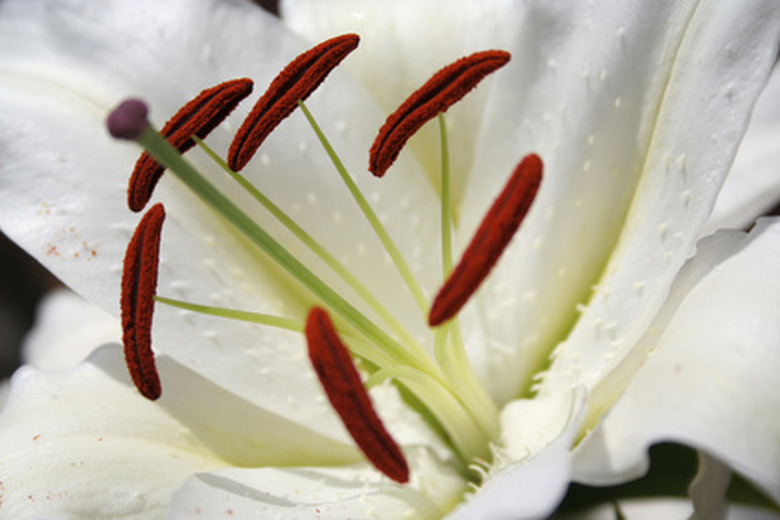Plant Identification Of White Flowers
The world of white flowered plants is enormous, including trees, shrubs, vines, annuals and perennials. When trying to identify a plant with white flowers, it is important to know whether the plant was found in a wild or domestic (garden) setting. Correct identification also depends on knowing when the flowers bloom: late winter, spring, summer or fall. Flower configuration is important too. White-petaled flowers can be bell-shaped, daisylike, umbeliferous (shaped like an upside-down, open umbrella) or grouped into flowerheads or stalks.
Daisies and Their Kin
If a plant has flowers in daisy form — white petals with yellow centers, it is probably a member of the Compositae or daisy family. Spring-blooming erigeron or fleabane is a common, white-petaled wildflower, as is the traditional ox-eye daisy. The ox-eye daisy's domesticated kin, shasta daisy, is a summer garden flower, distinguished by medium to tall stems and elongated, toothed leaves. A white flower with a cone-shaped center, is probably a cultivar of echinacea or purple coneflower. White asters, with their daisy blooms, are among the most common fall flowers in both wild and cultivated forms.
- The world of white flowered plants is enormous, including trees, shrubs, vines, annuals and perennials.
- The ox-eye daisy's domesticated kin, shasta daisy, is a summer garden flower, distinguished by medium to tall stems and elongated, toothed leaves.
White Roses
Members of the Rosaceae or rose family are distinguished — at least in species form — by five-petaled flowers. There are many white-flowered rose relatives. In the late spring in the United States, thickets of fragrant Rosa multiflora, a Japanese rose with small white flowers, dominate waste spaces. Strawberries, both wild and domestic, have a creeping habit and white flowers, followed by red fruit. The late spring flowers of raspberries and blackberries are also white with five petals apiece. These shrubs are distinguished by thorny canes and leaflets in configurations of three or five.
White Lilies
True lilies are members of the genus Liliaceae and often sport white petals. Some members of the genus are easy to identify, like the distinctive cup-shaped flowers of white tulips. Probably the most famous cultivated lily is summer-blooming 'Casablanca', a hybrid Oriental lily distinguished by a tall stem, large white trumpet, whorls of elongated leaves and a strong, sweet fragrance. Fritillaria maleagris, a dainty spring bloomer, has a distinctive white form, appropriately called 'Alba'. Fritillaria has a willowy, 1-foot-tall stem and flowers shaped like downward-facing tulips.
- Members of the Rosaceae or rose family are distinguished — at least in species form — by five-petaled flowers.
- Some members of the genus are easy to identify, like the distinctive cup-shaped flowers of white tulips.
Vining Plants
A white-flowered vine with pointed, shield-shaped leaves and upward-facing trumpets is probably a wild or domestic convolvulus or morning glory or one of its kin, ipoemea. Convolvulus generally bloom in the summer. Vines with large-flowered, almost tropical daisylike blooms may be clematis. Like morning glories, they clamber up just about any support. White-flowered Clematis terniflora or sweet autumn clematis have 1-inch, star-shaped white flowers. Fragrant vining plants with five petals joined at the base to form a tube are probably members of the jasmine family.
White-Flowered Trees
Natives of the southern United States can almost always recognize white-flowered camellias, with their oval-shaped, glossy green leaves. A camellia relative, the late summer-blooming stewartia tree features five-petaled flowers with golden yellow stamens. Stewartia also has ovoid leaves and sometimes, exfoliating bark. In North America, hedgerows are often home to common hawthorne, a shrubby tree that is also a rose family member. Hawthorne can be identified by its divided or toothed leaves, spiny branches and white, clustered flowers.
- A white-flowered vine with pointed, shield-shaped leaves and upward-facing trumpets is probably a wild or domestic convolvulus or morning glory or one of its kin, ipoemea.
- Natives of the southern United States can almost always recognize white-flowered camellias, with their oval-shaped, glossy green leaves.
References
- "The Botanical Garden"; Roger Phillips and Martyn Rixs; 2002
- "Peterson Field Guides: Wildflowers"; Roger Tory Peterson and Margaret McKenny; 1968
